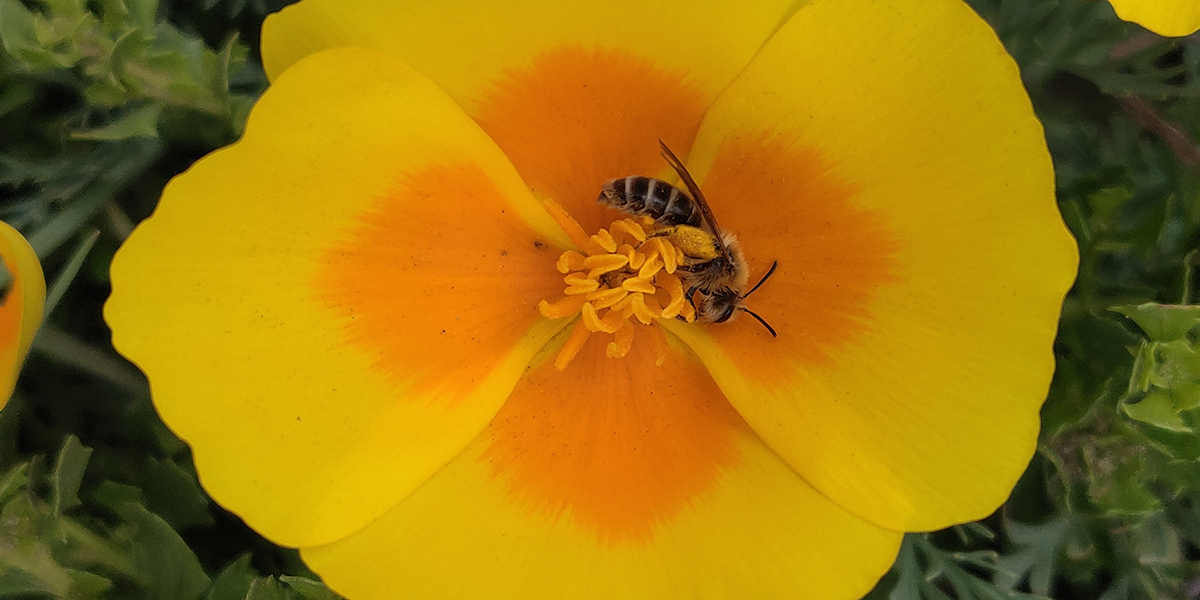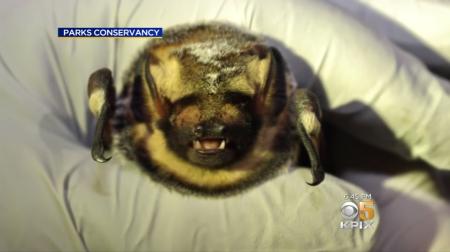
Photo: Sara Leon Guerrero/Parks Conservancy
Tamalpais Bee Lab News
- In 2024, the Bee Lab's search party for the San Francisco leaf-cutter bee (Trachusa gummifera) detected this rare species in Marin County! It hadn't been seen in Marin since 1977. There's still so much to learn about this special species and its ecology. Stay tuned to this page to learn more about our next steps, and how community scientists can help. Learn more about the search party below.
- See the news release about this exciting find here.
- Get your questions about T. gummifera answered here, plus resources for identifying bees you may be seeing in your own backyard or neighborhood.
Our Activities
What are the Bee Lab's current activities?
We are focused better understanding local bee communities, gathering information to inform future targeted monitoring studies, and contributing local data to broader efforts seeking to study and protect native bees. To achieve these goals, we are taking part in two established programs and starting one new effort. Each is described in more detail below, and there are ways for volunteers to get involved in all of them!
The California Bumble Bee Atlas (CABBA) is a collaborative community science effort, coordinated by the Xerces Society of Invertebrate Conservation and California Department of Fish and Wildlife, to track and conserve California’s native bumble bee species and contribute to the global understanding of bumble bee distributions.
Ground Nesting Bee surveys (GNBee) is a recent community science effort launched by the Danforth Lab at Cornell University to better understand and protect nests of ground-nesting bees. Approximately 75% of all native bee species nest in the ground and yet we still know relatively little about their requirements and preferences for nesting habitat. By participating in this project, community scientists can help fill critical knowledge gaps on where and when bees nest so researchers and land managers can better work to protect and promote them in our public lands.
The San Francisco Bay Area Leaf-cutter Bee Search Party is a new effort to find Trachusa gummifera, a rare endemic bee species only known from a few historical records, which has been missing for decades and was last seen in the Mt. Tam region. Despite being identified as a species of special concern by the CA Department of Fish and Wildlife, little is known about this species' biology and ecology, and there have been no recent efforts to learn more. The rarity and lack of knowledge of T. gummifera and its habitat requirements make it difficult to assess its conservation status and needs. Conducting dedicated surveys to document its continued existence and identify habitat associations will help fill these knowledge gaps and will provide data for future research and management.
How are surveys conducted?
Each survey has a different protocol that is determined by the study design, but in general each survey involves:
- Visiting a site designated by One Tam agency partners as an area of interest.
- Searching for bees or their nest sites.
- Documenting the bees and/or nest sites with high quality photographs.
- Uploading the photographs and metadata to a portal for identification by experts.
If you would like to know the details of the CABBA and GNBee surveys, you can find more information on their websites:
• CABBA – About the Project and Point Survey Protocol
• GNBee – About the Project and Reporting Observations
.jpg)
Staff and volunteers participate in a California Bumble Bee Atlas training. Photo:Kelly Sullivan for the Parks Conservancy
Get Involved!
Community science volunteers play a critical role in this work! Volunteers can participate in these efforts in two ways:
- Attend a regularly scheduled TBL event and conduct surveys at predetermined sites with One Tam staff and other volunteers.
- Attend a TBL training in the spring and adopt a predetermined site to conduct surveys by yourself or with your family and friends.
REGISTRATION FOR ALL DATES HERE >>
Spring 2025 dates are listed in the table below. The registration link (above) remains the same for all dates. Please sign up for our seasonal e-newsletter and check our calendar to hear about all our community science opportunities.
Date | Event | Location |
Saturday, April 19 | California Bumble Bee Atlas | Sky Oaks Watershed Headquarters |
Saturday, April 26 | California Bumble Bee Atlas | Lake Lagunitas |
Saturday, May 3 | California Bumble Bee Atlas | Sky Oaks Watershed Headquarters |
Saturday, May 10 | California Bumble Bee Atlas | Lake Lagunitas |
If you have questions, please email communityscience@onetam.org
Background
The Tamalpais Bee Lab is a One Tam effort to monitor and understand more about Mt. Tamalpais' local wild bees and other pollinators.
From 2017-2022, in collaboration with Dr. Gretchen LeBuhn and her lab at San Francisco State University, we completed an initial 2017 survey of Mt. Tam’s wild bees. This work stems from One Tam's Peak Health effort to understand the health of Mt. Tam's natural resources, where we saw we needed to learn more about the region's pollinators.
The initial survey yielded remarkable results, recording 32 genera and 122 bee species from 20 sites managed by Marin Water and California State Parks. You can hear more about these results from Dr. LeBuhn and Dr. Lisette Arellano, One Tam’s Community Science Sr. Program Manager. We then expanded the survey to other One Tam partner lands in subsequent years. We now have records of 276 bee species in Marin County and believe there could be as many as 300-400! Our most recent results can be found in our 2023 Peak Health report.
Our team has been busy preparing the collections that our volunteers helped us manage over the last year to send to the USDA for species identification. For 2024-25, after a lot of planning, we are transitioning the Tamalpais Bee Lab the targeted monitoring efforts described above, and offering new volunteer opportunities!

